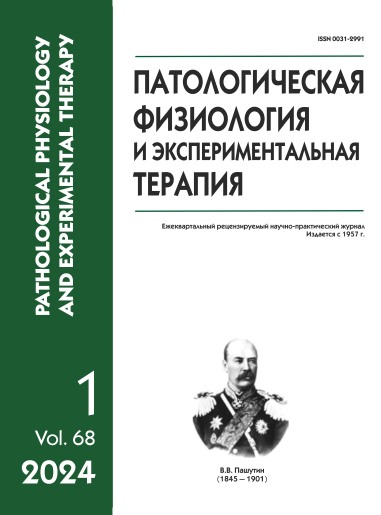The biological effect of stevia leaf extract on metabolic processes in c57bl/6 mice
Abstract
Aim: To study the effect of chronic treatment with stevia (Stevia rebaudiana Bertoni) leaf extract (SLE), that is widely used as a sweetener, on blood biochemistry and the state of internal organs in sexually mature C57BL/6 female mice (Mus musculus domesticus).
Methods. Animals were divided into three groups: a control group and two experimental groups. The mice received a SLE water solution at doses of one (permissible daily dose, PDD) and 10 mg/g of body weight, respectively, for two months.
Results. The study showed an increase in total cholesterol and decreases in triacylglycerols and blood glucose without a dose-dependent effect. Decreases in the weight of the pancreas, liver, and heart were observed only in the group receiving the SLE at PDD. In the same group, increases in the weight of the kidneys and spleen were observed. Also, the SLE treatment resulted in discoloration of the kidneys, spleen and liver, and, in some cases, hydronephrotic changes in the kidneys.
Conclusion. Thus, the chronic treatment with the SLE had both positive and negative effects, which necessitates a more accurate determination of the SLE PDD.
Downloads
References
2. Latarissa I. R., Barliana M. I., Lestari K. A Comprehensive Review of Stevia rebaudiana Bertoni effects on Human Health and Its Mechanism //Journal of Advanced Pharmacy Education & Research. – 2020. – Т. 10.
3. Directive 2010/63/EU of the European Parliament and of the Council of 22.09.2010 on the protection of animals used for scientific purposes. - Strasbourg, 2010. - 19с.
4. World Medical Association. World Medical Association Declaration of Helsinki: Ethical Principles for Medical Research Involving Human Subjects. JAMA. 2013;310(20):2191–2194. doi:10.1001/jama.2013.281053.
5. Walton K., Walker R., Van De Sandt J. J. M., Castell J. V., Knapp A. G. A. A., Kozianowski G., The application of in vitro data in the derivation of the acceptable daily intake of food additives //Food and Chemical Toxicology. – 1999. – Т. 37. – №. 12. – С. 1175-1197.
6. Beshara A., Cohen E., Goldberg E., Lilos P., Garty M., Krause I. Triglyceride levels and risk of type 2 diabetes mellitus: a longitudinal large study // Journal of Investigative Medicine. – 2016. – V. 64. – №. 2. – 83–385 p.
7. Ahmad U., Ahmad R. S., Arshad M. S., Mushtaq Z., Hussain S. M., Hameed, A. Antihyperlipidemic efficacy of aqueous extract of Stevia rebaudiana Bertoni in albino rats //Lipids in health and disease. – 2018. – Т. 17. – С. 1-8.
8. Farid A., Hesham M., El-Dewak M., Amin A. The hidden hazardous effects of stevia and sucralose consumption in male and female albino mice in comparison to sucrose // The Saudi Pharmaceutical Journal. – 2020. – V. 28. – №. 10. – 1290–1300 p.
9. Chen T., Chen S., Chan P., Chu Y., Yang H., Cheng J. Mechanism of the Hypoglycemic Effect of Stevioside, a Glycoside of Stevia rebaudiana //Planta Med. – 2005. – V. 71. – №. 2. – 108–113 p.
10. Stranders I., Diamant M., van Gelder R. E., Spruijt H. J., Twisk J. W., Heine R. J. et al. Admission Blood Glucose Level as Risk Indicator of Death After Myocardial Infarction in Patients With and Without Diabetes Mellitus // Arch Intern Med. – 2004. – V. 164. – №. 9. –982–988 p.
11. Barriocanal L.A., Palacios M., Benitez G., Benitez S., Jimenez J.T., Jimenez N., et al. Apparent lack of pharmacological effect of steviol glycosides used as sweeteners in humans. A pilot study of repeated exposures in some normotensive and hypotensive individuals and in Type 1 and Type 2 diabetics // Regulatory Toxicology and Pharmacology. – 2008. – V. 51. – 37–41 p.
12. Hsieh M., Chan P., Sue Y., Liu J., Liang T.H., Huang T., et al. Efficacy and tolerability of oral stevioside in patients with mild essential hypertension: a two-year, randomized, placebo-controlled study // Clinical Therapeutics. – 2003. – V. 25. – №. 11. –2797–2808 p.
13. Jeppesen P., Barriocanal L., Meyer M., Palacios M., Canete F., Benitez S., et al. Efficacy and tolerability of oral stevioside in patients with type 2 diabetes: A long-term, randomized, double-blinded, placebo-controlled study // Diabetologia. – 2006. – V. 49. – №. 1. – 511–512 p
14. Asia Pacific Cohort Studies Collaboration. Cholesterol, diabetes and major cardiovascular diseases in the Asia-Pacific region // Diabetologia. – 2007. – V. 50. – 2289 –2297 p.
15. Panpatil V. V., Polasa K. Assessment of stevia (Stevia rebaudiana)--Natural sweetener: A review //Journal of Food Science and Technology. – 2008. – Т. 45. – №. 6. – С. 467.






